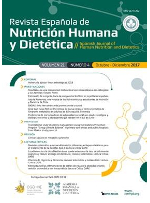Hospital nutrition: dietary intake characteristics among adults with NCDs (Algeria, 2020)
Hospital nutrition: dietary intake characteristics among adults (Algeria, 2020)
DOI:
https://doi.org/10.14306/renhyd.26.2.1506%20Keywords:
Eating, Recommended Dietary Allowances, Inpatients, Malnutrition, Noncommunicable Diseases, AlgeriaAbstract
Introduction: Hospital malnutrition is a common problem among non-communicable diseases' (NCDs) inpatients, and it is related to food intake characteristics. The aim of this study was to determine the current dietary intake characteristics of hospitalized adults with NCDs in Algeria.
Methods: The study sample consisted of 105 inpatients. The dietary intake was evaluated using the 24 hours recall method, CIQUAL Table, 2016 was used for nutritional values and Subjective global assessment (SGA) for the nutritional status assessment.
Results: The study design responds to a descriptive cross-sectional study carried out on a sample of 105 inpatients. The malnutrition percentage was 44.76% (B/C on SGA). Most consumed food was self-provided (78.09%) and 3.81% of food was hospital-provided. Energy intakes were low with a median of 4805 kJ/day; 24.76% of participants met 100% of their energy requirements while 13.33% met ≥75% of their protein requirements with no significant difference between well-nourished and malnourished patients. Dietary sugar was higher than 10% of total energy, and alpha-linolenic acid was at 0.06% of total energy with severe deficient of vitamins and minerals.
Conclusions: Current food supply including non-regulated sources in hospital was not able to meet the dietary requirements of inpatients. Improving hospital nutritional services, supporting patients at mealtimes and nutritional education among patients’ families are solutions to improve patient nutritional status.
References
(1) Abd-El-Gawad WM, Rasheedy D. Nutrition in the Hospitalized Elderly. Mol Basis Nutr Aging A Vol Mol Nutr Ser. 2016:57-72. doi:10.1016/B978-0-12-801816-3.00006-6
(2) Meira D, Lavoura P, Ferreira D, et al. Impact of hospitalization in the functionality and quality of life of adults and elderlies. Eur Respir J. 2015;46(suppl 59). doi:10.1183/13993003.congress-2015.PA3547
(3) Mollon D. Feeling safe during an inpatient hospitalization: A concept analysis. J Adv Nurs. 2014;70(8):1727-1737. doi:10.1111/jan.12348
(4) Kaegi-Braun N, Mueller M, Schuetz P, Mueller B, Kutz A. Evaluation of Nutritional Support and In-Hospital Mortality in Patients with Malnutrition. JAMA Netw Open. 2021;4(1). doi:10.1001/JAMANETWORKOPEN.2020.33433
(5) Barker LA, Gout BS, Crowe TC. Hospital malnutrition: Prevalence, identification and impact on patients and the healthcare system. Int J Environ Res Public Health. 2011;8(2):514-527. doi:10.3390/ijerph8020514
(6) Boutata FZ, Bencharif M, Abdessemed D. Validity of four nutritional screening tools against subjective global assessment for inpatients with non communicable diseases ( Algeria , 2020 ). Nutr Clin Metab. 2020.
(7) Muscaritoli M, Krznarić Z, Singer P, et al. Effectiveness and efficacy of nutritional therapy: A systematic review following Cochrane methodology. Clin Nutr. 2017;36(4):939-957. doi:10.1016/j.clnu.2016.06.022
(8) Lew CCH, Yandell R, Fraser RJL, Chua AP, Chong MFF, Miller M. Association between Malnutrition and Clinical Outcomes in the Intensive Care Unit: A Systematic Review. J Parenter Enter Nutr. 2017;41(5):744-758. doi:10.1177/0148607115625638
(9) Tappenden KA, Quatrara B, Parkhurst ML, Malone AM, Fanjiang G, Ziegler TR. Critical Role of Nutrition in Improving Quality of Care: An Interdisciplinary Call to Action to Address Adult Hospital Malnutrition. J Acad Nutr Diet. 2013;113(9):1219-1237. doi:10.1016/j.jand.2013.05.015
(10) Mitchell H, Porter J. The cost-effectiveness of identifying and treating malnutrition in hospitals: A systematic review. J Hum Nutr Diet. 2016;29(2):156-164. doi:10.1111/jhn.12308
(11) Abizanda P, Sinclair A, Barcons N, Lizán L, Rodríguez-Mañas L. Costs of Malnutrition in Institutionalized and Community-Dwelling Older Adults: A Systematic Review. J Am Med Dir Assoc. 2016;17(1):17-23. doi:10.1016/j.jamda.2015.07.005
(12) Rasheed S, Woods RT. An investigation into the association between nutritional status and quality of life in older people admitted to hospital. J Hum Nutr Diet. 2014;27(2):142-151. doi:10.1111/jhn.12072
(13) Áncer-Rodríguez PR, Porrata-Mauri C, Hernández-Triana M, et al. Nutritional screening and prevalence of hospital malnutrition risk. University Hospital of the UANL, Monterrey. Med Univ. 2014;16(65):165-170. www.elsevier.es/en/node/2090153.
(14) Evans WJ. Nutritional Support Should Target the Cause of Malnutrition in Hospitalized Patients. JAMA Netw Open. 2021;4(1). doi:10.1001/JAMANETWORKOPEN.2020.33925
(15) Brito NB. El Dietista-Nutricionista dentro del Sistema Nacional de Salud Español: Abordando la desnutrición hospitalaria. Rev Esp Nutr Humana y Diet. 2017;21(2):199-208. doi:10.14306/renhyd.21.2.248
(16) Bandyopadhyay S, Maji B, Mitra K. A Study on Adherence to Medicines and Lifestyle of Diabetic Patients Attending a Tertiary Care Hospital in Kolkata Post-coronavirus Disease Lockdown. Ann Community Heal. 2021;9(02):91-94.
(17) Hernández-Galdamez DR, González-Block MÁ, Romo-Dueñas DK, et al. Increased Risk of Hospitalization and Death in Patients with COVID-19 and Pre-existing Noncommunicable Diseases and Modifiable Risk Factors in Mexico. Arch Med Res. 2020;51(7):683-689. doi:10.1016/j.arcmed.2020.07.003
(18) Löser C. Unter- und mangelernährung im krankenhaus - Klinische folgen, moderne therapiestrategien, budgetrelevanz. Dtsch Arztebl. 2010;107(51-52):911-917. doi:10.3238/arztebl.2010.0911
(19) Swe EE, Htet KKK, Thekkur P, Aung LL, Aye LL, Myint T. Increasing trends in admissions due to non-communicable diseases over 2012 to 2017: Findings from three large cities in Myanmar. Trop Med Health. 2020;48(1). doi:10.1186/s41182-020-00209-8
(20) Cederholm T, Barazzoni R, Austin P, et al. ESPEN guidelines on definitions and terminology of clinical nutrition. Clin Nutr. 2017;36(1):49-64. doi:10.1016/j.clnu.2016.09.004
(21) Makhija S, Baker J. The subjective global assessment: A review of its use in clinical practice. Nutr Clin Pract. 2008;23(4):405-409. doi:10.1177/0884533608321214
(22) Campbell KL, Ash S, Bauer J, Davies PSW. Critical review of nutrition assessment tools to measure malnutrition in chronic kidney disease. Nutr Diet. 2007;64(1):23-30. doi:10.1111/j.1747-0080.2007.00116.x
(23) Ciqual Table de composition nutritionnelle des aliments. https://ciqual.anses.fr/. Accessed December 21, 2021.
(24) Thibault R, Makhlouf A-M, Kossovsky MP, et al. Healthcare-Associated Infections Are Associated with Insufficient Dietary Intake: An Observational Cross-Sectional Study. 2015. doi:10.1371/journal.pone.0123695
(25) Kleiner J. European Food Safety Authority: Dietary Reference Values.; 2009. https://www.efsa.europa.eu/en/topics/topic/dietary-reference-values. Accessed August 24, 2021.
(26) Tran QC, Banks M, Do TND, Gallegos D, Hannan-Jones M. Characteristics of dietary intake among adult patients in hospitals in a lower middle-income country in Southeast Asia. Nutr Diet. 2019;76(3):321-327. doi:10.1111/1747-0080.12504
(27) Pekmezci AG, Gündoğan K, Dizdar OS, Meşe EA. Daily energy and protein intake in hospitalized patients in department of infectious diseases: A prospective observational study. Prog Nutr. 2018;20(February 2020):98-105. doi:10.23751/pn.v20i2-S.5448
(28) Ingadottir AR, Beck AM, Baldwin C, et al. Association of energy and protein intakes with length of stay, readmission and mortality in hospitalised patients with chronic obstructive pulmonary disease. Br J Nutr. 2018;119(5):543-551. doi:10.1017/S0007114517003919
(29) Bonnefoy M, Gilbert T, Normand S, et al. Energy expenditure in older people hospitalized for an acute episode. Nutrients. 2019;11(12):1-14. doi:10.3390/nu11122946
(30) Pourhassan M, Daubert D, Wirth R. Measured and predicted resting energy expenditure in malnourished older hospitalized patients: A cross‐sectional and longitudinal comparison. Nutrients. 2020;12(8):1-9. doi:10.3390/nu12082240
(31) Leistra E, Willeboordse F, van Bokhorst - de van der Schueren MAE, et al. Predictors for achieving protein and energy requirements in undernourished hospital patients. Clin Nutr. 2011;30(4):484-489. doi:10.1016/j.clnu.2011.01.008
(32) Fernández AC, de la Maza BP, Casariego AV, et al. Influencia de la ingesta y el estado nutricional en las complicaciones de los pacientes oncohematológicos hospitalizados. Nutr Hosp. 2015;31(6):2598-2605. doi:10.3305/nh.2015.31.6.8674
(33) Shirado K, Wakabayashi H, Maeda K, et al. Impact of Energy intake at One Week after Hospitalization on Prognosis for Older Adults with Pneumonia. J Nutr Heal Aging. 2020;24(1):119-124. doi:10.1007/s12603-019-1282-y
(34) Kontogianni MD, Poulia KA, Bersimis F, et al. Exploring factors influencing dietary intake during hospitalization: Results from analyzing nutritionDay’s database (2006–2013). Clin Nutr ESPEN. 2020;38:263-270. doi:10.1016/j.clnesp.2020.04.001
(35) Ridley EJ, Chapple LAS, Chapman MJ. Nutrition intake in the post-ICU hospitalization period. Curr Opin Clin Nutr Metab Care. 2020;23(2):111-115. doi:10.1097/MCO.0000000000000637
(36) Agarwal E, Ferguson M, Banks M, Bauer J, Capra S, Isenring E. Nutritional status and dietary intake of acute care patients: Results from the Nutrition Care Day Survey 2010. Clin Nutr. 2012;31(1):41-47. doi:10.1016/j.clnu.2011.08.002
(37) Jiyana M., Ncube L, Nesamvuni A. Nutrient composition of planned adult patients’ normal diet menus in selected public hospitals in Gauteng Province, South Africa. African Journal for Physical Activity and Health Sciences (AJPHES). https://www.researchgate.net/publication/328043455_Nutrient_composition_of_planned_adult_patients%27_normal_diet_menus_in_selected_public_hospitals_in_Gauteng_Province_South_Africa. Published 2018.
(38) Carreiro AL, Dhillon J, Gordon S, et al. The Macronutrients, Appetite, and Energy Intake. Annu Rev Nutr. 2016;36:73-103. doi:10.1146/annurev-nutr-121415-112624
(39) Lee E, Choi J, Ahn A, Oh E, Kweon H, Cho D. Acceptable macronutrient distribution ranges and hypertension. Clin Exp Hypertens. 2015;37(6):463-467. doi:10.3109/10641963.2015.1013116
(40) Manore MM. Exercise and the Institute of Medicine for Nutrition. Curr Sport Med Rep. 2005;4(4):193-198.
(41) Australian National Health and Medical Research Council. Macronutrient Balance | Nutrient Reference Values. Nutr Ref Values Aust New Zeal. 2015. https://www.nrv.gov.au/chronic-disease/macronutrient-balance.
(42) Clemens RA, Jones JM, Kern M, et al. Functionality of Sugars in Foods and Health. Compr Rev Food Sci Food Saf. 2016;15(3):433-470. doi:10.1111/1541-4337.12194
(43) Dahl WJ, Stewart ML. Position of the Academy of Nutrition and Dietetics: Health Implications of Dietary Fiber. J Acad Nutr Diet. 2015;115(11):1861-1870. doi:10.1016/j.jand.2015.09.003
(44) Stark AH, Crawford MA, Reifen R. Update on alpha-linolenic acid. Nutr Rev. 2008;66(6):326-332. doi:10.1111/j.1753-4887.2008.00040.x
Downloads
Published
How to Cite
Issue
Section
License
Copyright (c) 2020 Fatima Zohra Boutata, Meriem Bencharif, Dalila Abdessemed

This work is licensed under a Creative Commons Attribution-NonCommercial-ShareAlike 4.0 International License.











